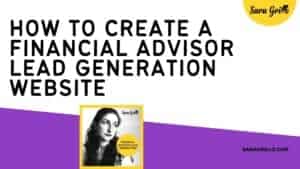While Picasso didn’t attend marketing conferences with titles such as “Brand Ambassador” on his name tag, financial advisors can all take a lesson from his success in marketing his product.
Marketing as an Art Form
As business owners, and especially those with emerging brands, we’re all Picasso figures in some way. We’re all striving for the same goal as he was: to bring to life a business product or service and have it ultimately change the world. The great question is how Picasso and other monumental successes in history were able to gain the power that they did, while others just don’t quite get there.
What for many of separates us from Picasso is the way the collage comes together. For many firms, and especially those without resources dedicated to this, marketing presentation resembles more a thrown together sundry tools rather than a beautifully arranged assortment of symbolic ideas that represent the company’s brand.
This analogy is best served by an example. While the following refers to no one company in particular, to many it may sound familiar.
What is a Chaotic Picasso?
The Facebook page was created by an intern two summers ago, and you can’t find the password anywhere although updates are happening on a regular basis. LinkedIn hasn’t been touched in months, the website was created by a marketing consultant who has long since departed, and the logo and tagline are from your brother-in-law who is a graphic designer. Now your buddy from college whom you saw at last week’s reunion wants to come in and do some pay per click advertising but you’re not sure how effective it will be since you haven’t checked Google Analytics in over a year.
Or maybe you’re making some business card mistakes such as information overload, overly fancy font, or no space for notes. For more information on how to avoid this, check out this blog post by Heike Heemann of IdeaShare Business Coaching.
Recognize this picture? I call it a Chaotic Picasso.
The inevitable result of a Chaotic Picasso is that after some time of flustered sales and marketing success, management decides to execute what is called a “rebrand.” You’ve seen this before: redo the logo, upgrade the website, maybe add a blog or two every month. Most of the time this just adds weight to the pile. It seems that the organization has sorted its Picasso out, but it doesn’t stay that way for long and a few years later the company is in the same position.
So if you’re a Chaotic Picasso, how do you become a Picasso?
Said differently, how can a Chaotic Picasso be transformed into a marketing masterpiece? As one of my branding colors is purple, I’ve created an analogy called a “Sara’s Purple Book of Branding” to explain the solution to this problem.
Here are the parts of a Sara’s Purple Book.
Marketing Assets (Dark Purple)
Just like an asset, the marketing tools your company uses are expected to yield more value than what you paid. Treat these assets like cash in your bank account. Create an inventory of every single marketing asset, from logo to newsletters to sales people, and then rank them in order of potency. You’ll be surprised at how much you have to work with. This list changes as your marketing evolves.
Marketing Strategy (Pale Purple)
It’s in the background, but it’s always there. In essence, the marketing assets come alive through the brand. View my blog about business branding to learn how. It’s one of the hardest things for companies to develop when the Picasso is chaotic. That’s why a strategic approach to branding is key.
Marketing Execution Plan (Bright Purple)
This actually should be green, because that’s what brings the money in; but as this is a Sara’s Purple Book, green is excluded. Executing the brand is where you gain the value in the marketplace that you deserve. What many companies forget about marketing is that it’s supposed to create revenue. Most organizations assign that responsibility to the sales force. While it’s true that the salesperson is the one who ultimately gets the buyer to sign the paper, marketing is the language of sales. The greatest problem for most sales operations is a smaller than needed pipeline.
Solid branding and messaging are a powerful signal to the buyer that can make or break a sales effort. If something is wrong with them, the salesperson has to work that much harder to get to where your competition already is.
Here’s an example.
You meet a colleague at a networking event who tells you that she is in the market for your product. You exchange business cards and have a great intro call. She wants to move to the next step, but curiously your phone calls and emails for the next two weeks are ignored. Maybe she’s all of a sudden got a family emergency, or maybe she has taken up with one of your competitors. You’ll never know the truth so now you have to rely upon your brand to save the deal.
What’s critical in this situation to avoid being perceived as a valueless stalker is to have marketing assets to deploy in a way that drive home your value. That’s the difference between stalking and value added follow up. You won’t get much of her attention now that the communication has been broken. You need marketing assets that get her attention the right way and convey the value you are worth in the marketplace or else it’s phone tag and voicemail for the rest of your days.
Sara’s Upshot
Authenticity is what matters most in any financial advisor who wants to get new clients. Learn the no BS way to use social media to get new clients by joining my membership here.





